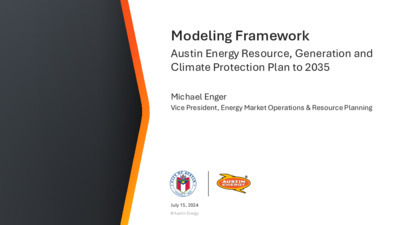Item 10- Modeling Framework AE Resource, Generation, and Climate Protection Plan 2035 Briefing — original pdf
Backup

Modeling Framework Austin Energy Resource, Generation and Climate Protection Plan to 2035 Michael Enger Vice President, Energy Market Operations & Resource Planning July 15, 2024 © Austin Energy Agenda Role of Modeling in Resource Planning Enhancements to Modeling Approach Comparison of Modeling Tools Introduction to Ascend Analytics Team Overview of Model Inputs and Assumptions Modeling Timeline and Next Steps 2 Role of Modeling in Resource Planning Portfolio Performance Demonstrate how different mixes of energy resources perform financially and operationally in normal and extreme conditions Risk Mitigation Test portfolios against congestion constraints and low-probability, high-impact events Understand Tradeoffs Quantify how improvements to a portfolio's performance in sustainability, affordability or reliability affect other objectives 3 Enhancements to Modeling Approach Full 2035 Plan developed Third party input on technology costs, load growth and market potential Stakeholder input on portfolio design and evaluation criteria Independent modeling conducted in parallel by a consultant 4 Modeling Process Portfolios Scenarios Model Inputs & Assumptions Sensitivity Analysis Portfolio E Portfolio G Portfolio C Examples: high load growth, fuel costs, etc. High Impact Events Local Congestion Regulatory Change Portfolio A __ MW Solar __ MW Storage __ MW DR Portfolio B Portfolio C Portfolio D Portfolio E Portfolio F Portfolio G Output Results Levelized Cost Rate Impact Outage Frequency Emissions Liquidity Risk Note: for shortlist portfolios 5 Austin Energy Portfolio Modeling Overview Internal Modeling Process Utilizing UPLAN and PowerSIMM modeling tools to evaluate the performance of multiple portfolios across various scenarios. 3rd Party Modeling Process Ascend’s resource planning methodology and modeling tools generate optimized portfolios based on specified constraints. Portfolio Evaluation All modeling results will be evaluated to select portfolios for further consideration. PORTFOLIO A PORTFOLIO B PORTFOLIO C PORTFOLIO D PORTFOLIO E PORTFOLIO F Shortlist of Portfolios 6 Ascend Introduction 7 About Ascend Analytics • • • Founded in 2002 with ~160 employees in Boulder, Oakland, and Bozeman Six integrated service lines for asset operations, portfolio analytics, and planning Custom analytical solutions and consulting The Ascend Product Suite Ascend Team Title Team Member Brandon Mauch, Ph.D. Managing Director Ben Anderson Sameera Gudladona Jessica de la Paz David Dong Manager Principal Energy Analyst Modeling Lead Model Support Energy Analyst Model Support Energy Analyst Role Project Lead Project Manager 9 Recent Resource Planning at Ascend Los Angeles Dept of Water and Power Ascend ran the modeling for LADWP’s 2022 and 2024 Strategic Long Term Resource Plan (SLTRP). The SLTRP lays out an ambitious plan to move LADWP to a 100% clean energy grid by 2035. Ascend provided all modeling and assisted with stakeholder engagement. Grant County Public Utility District Grant PUD used Ascend to model their hydro heavy system for the 2022 IRP. The plan provided a roadmap for Grant PUD to meet increasing load while satisfying the state of Washington’s Clean Energy Transformation Act which sets milestones for a 100% clean energy transition by 2045. Ascend ran the 2023 IRP for the City of Lansing in Michigan. The IRP laid out a pathway for the city to procure over 650 MW of clean energy. Ascend also administered the procurement process for Lansing to achieve the plan it laid out. City of Lansing State of Colorado The Colorado Energy Office commissioned Ascend to perform a study evaluating pathways to a 100% clean grid by 2040. The project resulted in report used in crafting energy policy for Colorado’s Roadmap to 100% Clean Energy. In 2023, Ascend completed 15 IRPs for utilities including IOUs, Munis, and Public Power 10 Resource Planning Goals • Identify resources best suited to match the needs of Austin • Provide insight into future system operations • Create resource portfolios that meet the community priorities at the lowest possible cost Reliability Sustainability Equity Affordability 11 Questions? 12 Model Inputs/Assumptions Future State Supply & Demand Costs Economic Parameters Emissions Load forecast (Austin Energy & ERCOT) Technology-specific capital and O&M costs Inflation rate Austin Energy demand side projections Generation + PPA additions/retirements (Austin Energy) ERCOT model additions/retirements Fuel costs Cost of capital Discount rate % debt Unit-specific emission factors (NOx, CO2, SOx, PM) Technology-specific emission factors (new sources) 13 Model Outputs – Measure of Portfolio Performance Each portfolio-scenario combination will generate a set of metrics that will be used to evaluate and prioritize portfolios Levelized Cost Total # of Local Load Shed Events Total CO2 Emissions (Austin Energy) Rate Impact Total Hours Local Load Shed Events Total CO2 Emissions (ERCOT Energy Burden Impact Total Liquidity Need NOx Emissions 14 Modeling Timeline Modeling Framework to EUC 7/10/24 Portfolios + Scenarios to EUC 8/5/24 Modeling Results + Recommendations to EUC September 2024 JUNE JULY AUG SEPT Data Sources 7/8 Webber Draft Report 7/31 DNV Study Preliminary Results Final Model Runs 7/15 EUC Input on Framework 8/12 EUC Input on Portfolios + Scenarios 15 ©Austin Energy. All rights reserved. Austin Energy and the Austin Energy logo and combinations thereof are trademarks of Austin Energy, the electric department of the City of Austin, Texas. Other names are for informational purposes only and may be trademarks of their respective owners.